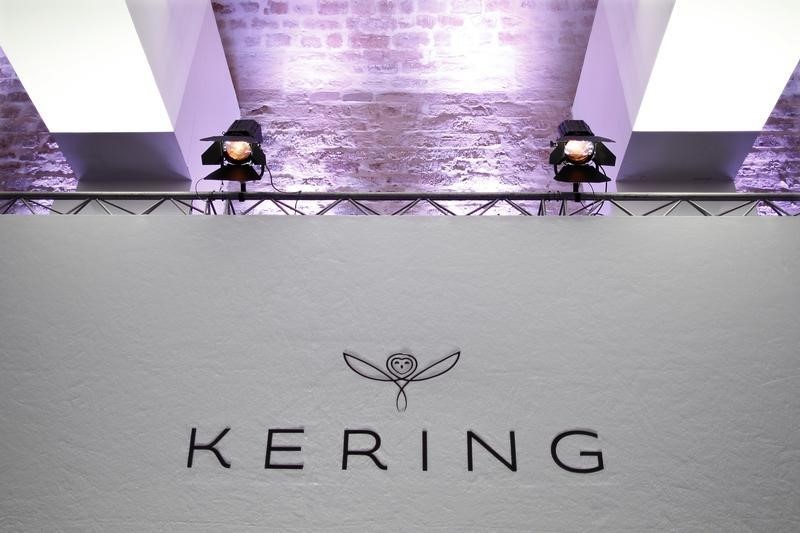Investing.com -- Shares of Kering (EPA:PRTP) fell on Tuesday following a downgrade from Goldman Sachs, revising the luxury conglomerate's rating to "sell."
At 3:51 am (0750 GMT), Kering was trading 2.9% lower at €249.50.
The downgrade reflects concerns over Kering's flagship brand, Gucci, which has struggled to maintain its momentum in recent years.
After a period of stellar growth between 2016 and 2019, Gucci has faced headwinds since 2020, and despite efforts to reverse market share decline, the results have yet to stabilize.
The downgrade is largely driven by concerns about weaker-than-expected growth in China, a key market for luxury goods. China’s economy has been slowing, and despite recent stimulus measures aimed at boosting consumer confidence, Goldman Sachs remains skeptical about their ability to drive high-end discretionary spending in the near term.
The brokerage notes that the luxury sector tends to be late in the recovery cycle, and any improvement in broader consumer spending is likely to be felt later in luxury purchases. This has made China a critical point of debate in evaluating the outlook for luxury brands like Kering.
Goldman Sachs flags that, despite policy interventions, it foresees downside risks in China’s luxury consumption trends. Early data from the third quarter of 2024 indicates a continued weakness in consumer activity, even when compared to more favorable periods from the past.
Additionally, the ongoing deceleration in Japan, another critical market for Chinese luxury shoppers, adds further complexity to the picture.
Prices for luxury goods in Mainland China are approximately 25% to 30% higher than in Europe, which could limit the impact of reduced overseas spending on domestic luxury sales in China.
Kering’s downgrade also reflects concerns over the ongoing turnaround efforts at Gucci, which represents 64% of Kering’s EBIT forecast for FY24. The iconic brand has struggled to regain its former dominance, even after management changes, including the appointment of a new creative director.
Gucci’s revenue profile remains under pressure, with little indication that the brand has successfully stabilized its market share.
A major challenge for Gucci lies in the substantial investment needed to revitalize the brand. Key initiatives like developing new products, creating fresh content, and attracting customers are crucial for driving growth, but these efforts also increase the risk of operational inefficiencies.
In today’s market, where store traffic is sluggish and consumer confidence—especially in China—is low, executing Gucci’s ambitious plans may prove difficult.
Goldman Sachs expects Gucci’s EBIT margins to bottom out in the first half of 2025, adding further pressure on Kering’s overall profitability.
In terms of valuation, Kering's shares have already underperformed its luxury sector peers, dropping 28% year-to-date. However, Goldman Sachs identifies additional downside risks. The stock is currently trading at a 20x P/E for 2025, reflecting an 18% premium over the 10-year P/E average of 17x, excluding the COVID-19 period.
Goldman Sachs considers this valuation demanding, given the uncertainties around Kering’s earnings outlook, especially with Gucci undergoing a turnaround. The firm projects Kering’s EBIT for FY25 to be 11% below Visible Alpha consensus, pointing to the potential for further earnings disappointment.
The report also raises concerns about Kering’s broader portfolio. While Gucci remains the focal point, other brands within the Kering stable, such as Saint Laurent, are also undergoing significant investment phases, which could lead to greater earnings volatility compared to peers.
Goldman Sachs expects Kering’s EBIT margins to decline further in FY25, with the group’s adjusted EBIT margin forecast to drop to 15.8%, down from 30.1% in FY19, before the pandemic.
China remains a vital market for luxury goods, and despite changes in spending habits since the pandemic, it still represents about 25% of global luxury consumption. However, the contribution from Chinese consumers has declined from pre-pandemic levels of roughly 32%, with the majority of spending shifting from overseas purchases to domestic ones.
Goldman Sachs remains cautious on the Chinese consumer’s appetite for luxury goods in the near term, particularly in light of regional price differentials. With luxury items costing significantly more in China than in Europe, the firm sees limited potential for increased domestic spending to offset reduced travel and luxury shopping abroad.
As such, China’s importance to the industry remains undeniable, but the risks associated with its economic slowdown are now a central theme in Goldman’s assessment of the sector’s outlook.
Goldman Sachs' revised scenario flags increased downside risks from China. In a more challenging growth scenario, where Chinese luxury demand could drop by 10% in FY25, the luxury sector would likely face substantial pressure.
Goldman estimates an average downside of 34% for luxury stocks, including Kering. While the firm’s base case anticipates a modest 4% upside, the potential risks in this weaker growth environment significantly outweigh the possible gains.
